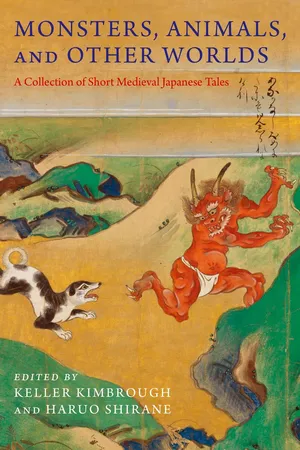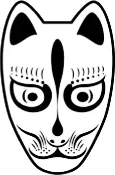
Monsters, Animals, and Other Worlds
A Collection of Short Medieval Japanese Tales
- English
- ePUB (mobile friendly)
- Available on iOS & Android
Monsters, Animals, and Other Worlds
A Collection of Short Medieval Japanese Tales
About this book
Monsters, Animals, and Other Worlds is a collection of twenty-five medieval Japanese tales of border crossings and the fantastic, featuring demons, samurai, talking animals, amorous plants, and journeys to supernatural realms. The most comprehensive compendium of short medieval Japanese fiction in English, Monsters, Animals, and Other Worlds illuminates a rich world of literary, Buddhist, and visual culture largely unknown today outside of Japan.
These stories, called otogiz?shi, or Muromachi tales (named after the Muromachi period, 1337 to 1573), date from approximately the fourteenth through seventeenth centuries. Often richly illustrated in a painted-scroll format, these vernacular stories frequently express Buddhist beliefs and provide the practical knowledge and moral education required to navigate medieval Japanese society. The otogiz?shi represent a major turning point in the history of Japanese literature. They bring together many earlier types of narrative—court tales, military accounts, anecdotes, and stories about the divine origins of shrines and temples––joining book genres with parlor arts and the culture of itinerant storytellers and performers. The works presented here are organized into three thematically overlapping sections titled, "Monsters, Warriors, and Journeys to Other Worlds," "Buddhist Tales," and "Interspecies Affairs." Each translation is prefaced by a short introduction, and the book features images from the original scroll paintings, illustrated manuscripts, and printed books.
Frequently asked questions
- Essential is ideal for learners and professionals who enjoy exploring a wide range of subjects. Access the Essential Library with 800,000+ trusted titles and best-sellers across business, personal growth, and the humanities. Includes unlimited reading time and Standard Read Aloud voice.
- Complete: Perfect for advanced learners and researchers needing full, unrestricted access. Unlock 1.4M+ books across hundreds of subjects, including academic and specialized titles. The Complete Plan also includes advanced features like Premium Read Aloud and Research Assistant.
Please note we cannot support devices running on iOS 13 and Android 7 or earlier. Learn more about using the app.
Information



Table of contents
- Cover
- Series Statement
- Frontispiece
- Title Page
- Copyright
- Dedication
- Contents
- Acknowledgments
- Introduction by Haruo Shirane
- Monsters, Warriors, and Journeys to Other Worlds
- Buddhist Tales
- Interspecies Affairs
- English-Language Secondary Sources
- Permissions
- Series List